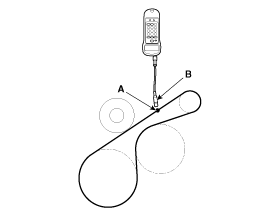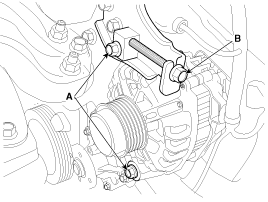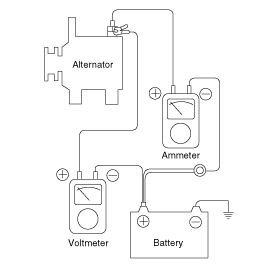 Kia Rio: Alternator: On-vehicle Inpection
Kia Rio: Alternator: On-vehicle Inpection
| •
Check that the battery cables are connected to the correct
terminals.
|
| •
Disconnect the battery cables when the battery is given
a quick charge.
|
| •
Never disconnect the battery while the engine is running.
|
Check The Battery Terminals And Fuses
|
1. |
Check that the battery terminals are not loose or corroded.
|
|
2. |
Check the fuses for continuity.
|
Inspect Drive Belt
|
1. |
Visually check the belt for excessive wear, frayed cords etc.
If any defect has been found, replace the drive belt.
Cracks on the rib side of a belt are considered acceptable.
If the belt has chunks missing from the ribs, it should be replaced.
|

Drive belt tension measurement and adjustment
| Belt tension measurement |
Measure the belt tension using a mechanical tension gauge or a sonic tension
meter.
Tension
New belt: 637.4 ~ 735.5N (65 ~ 75kg, 143.3 ~ 165.3lb)
Used belt: 490.3 ~ 588.4N (50 ~ 60kg, 110.2 ~ 132.3lb)
|
| •
If the engine has run for 5 minutes or more, the belt
tension must be adjusted as a used belt.
|
| •
When installing the V-ribbed belt, all grooves on the
pulley should be covered with belt ribs.
|
| •
A loose belt causes slip noise.
|
| •
Too tight belt cause bearing of alternator and water pump
to damage.
|
| Using a mechanical tension gauge (BT-33-73F,
BTG-2 type) |
|
1. |
While pressing the handle (A) of the gauge, insert the belt (B)
between pulley and pulley (or idler) into the gap between spindle (C)
and hook (D).

|
|
2. |
After releasing the handle (A), read a value on the dial pointed
by the indicator (B).

|
| Using a sonic tension meter (U-505/507
type) |
|
1. |
Input the belt specifications into the tension meter.
Belt type
|
Location of measurement
|
Input data
|
M (Mass, g/m.rib)
|
W (Width, rib)
|
S (Span, mm)
|
With A/C
|
Crankshaft pulley to A/C compressor pulley
|
013.4
|
006.0
|
178.9
|
Without A/C
|
Idler to alternator pulley
|
013.4
|
006.0
|
Actual measurement value
|
Measurement of S (Span) : Caculate average value after
measuring the distance 3~4 times.

D : Idler
d : Alternator pulley
|

|
2. |
Locate the micro phone (B) close to the center of belt span (A)
and bounce the belt by finger 2~3 times. Read a value on the display.
[With A/C]

[Without A/C]

|
| If adjustment is necessary : |
|
1. |
Loosen the mounting bolts (A).
|
|
2. |
Tighten the adjusting bolt(B) clockwise in loose tension ; loosen
the bolt counterclockwise in high tension.

|
|
3. |
Recheck tension of the belt.
|
|
4. |
After adjusting tension, tighten the through bolts.
Tightening torque
12mm (0.47in) bolt : 19.6 ~ 26.5 Nm (2.0 ~ 2.7 kgf.m,
14.5 ~ 19.5 Ib-ft)
14mm (0.55in) bolt : 29.4 ~ 41.2 Nm (3.0 ~ 4.2 kgf.m,
21.7 ~ 30.4 Ib-ft)
|
|
Visually Check Alternator Wiring And Listen For Abnormal Noises
|
1. |
Check that the wiring is in good condition.
|
|
2. |
Check that there is no abnormal noise from the alternator while
the engine is running.
|
Check Discharge Warning Light Circuit
|
1. |
Warm up the engine and then turn it off.
|
|
2. |
Turn off all accessories.
|
|
3. |
Turn the ignition switch "ON". Check that the discharge warning
light is lit.
|
|
4. |
Start the engine. Check that the light is lit.
If the light does not go off as specified, troubleshoot the discharge
light circuit.
|
Inspect Charging System
Voltage Drop Test Of Alternator Output Wire
This test determines whether or not the wiring between the alternator
"B" terminal and the battery (+) terminal is good by the voltage drop method.
Preparation
|
1. |
Turn the ignition switch to "OFF".
|
|
2. |
Disconnect the output wire from the alternator "B" terminal. Connect
the (+) lead wire of ammeter to the "B" terminal of alternator and the
(-) lead wire of ammeter to the output wire. Connect the (+) lead wire
of voltmeter to the "B" terminal of alternator and the (-) lead wire
of voltmeter to the (+) terminal of battery.

|
Test
|
1. |
Start the engine.
|
|
2. |
Turn on the headlamps and blower motor, and set the engine speed
until the ammeter indicates 20A.
And then, read the voltmeter at this time.
|
Result
|
1. |
The voltmeter may indicate the standard value.
Standard value :
0.2V max
|
|
|
2. |
If the value of the voltmeter is higher than expected (above 0.2V
max.), poor wiring is suspected. In this case check th e wiring from
the alternator "B" terminal to the battery (+) terminal. Check for loose
connections, color change due to an over-heated harness, etc. Correct
them before testing again.
|
|
3. |
Upon completion of the test, set the engine speed at idle.
Turn off the headlamps, blower motor and the ignition switch.
|
Output Current Test
This test determines whether or not the alternator gives an output current
that is equivalent to the normal output.
Preparation
|
1. |
Prior to the test, check the following items and correct as necessary.
Check the battery installed in the vehicle to ensure that it is
good condition. The battery checking method is described in the section
"Battery".
The battery that is used to test the output current should be
one that has been partially discharged. With a fully charged battery,
the test may not be conducted correctly due to an insufficient load.
Check the tension of the alternator drive belt. The belt tension
check method is described in the section "Inspect drive belt".
|
|
2. |
Turn off the ignition switch.
|
|
3. |
Disconnect the battery ground cable.
|
|
4. |
Disconnect the alternator output wire from the alternator "B"
terminal.
|
|
5. |
Connect a DC ammeter (0 to 150A) in series between the "B" terminal
and the disconnected output wire. Be sure to connect the (-) lead wire
of the ammeter to the disconnected output wire.
Tighten each connection securely, as a heavy current will
flow. Do not rely on clips.
|
|
6. |
Connect a voltmeter (0 to 20V) between the "B" terminal and ground.
Connect the (+) lead wire to the alternator "B" terminal and (-) lead
wire to a good ground.
|
|
7. |
Attach an engine tachometer and connect the battery ground cable.
|
|
8. |
Leave the engine hood open.

|
Test
|
1. |
Check to see that the voltmeter reads as the same value as the
battery voltage. If the voltmeter reads 0V, and the open circuit in
the wire between alternator "B" terminal and battery (+) terminal or
poor grounding is suspected.
|
|
2. |
Start the engine and turn on the headlamps.
|
|
3. |
Set the headlamps to high beam and the heater blower switch to
HIGH, quickly increase the engine speed to 2,500 rpm and read the maximum
output current value indicated by the ammeter.
After the engine start up, the charging current quickly
drops. Therefore, the above operation must be done quickly to
read the maximum current value correctly.
|
Result
|
1. |
The ammeter reading must be higher than the limit value. If it
is lower but the alternator output wire is in good condition, remove
the alternator from the vehicle and test it.
Limit value : 60%
of the voltage rate
|
|
|
•
The nominal output current value is shown on the
nameplate affixed to the alternator body.
|
|
•
The output current value changes with the electrical
load and the temperature of the alternator itself.
Therefore, the nominal output current may not
be obtained. If such is the case, keep the headlamps
on the cause discharge of the battery, or use the lights
of another vehicle to increase the electrical load.
The nominal output current may not be obtained
if the temperature of the alternator itself or ambient
temperature is too high. In such a case, reduce the
temperature before testing again.
|
|
2. |
Upon completion of the output current test, lower the engine speed
to idle and turn off the ignition switch.
|
|
3. |
Disconnect the battery ground cable.
|
|
4. |
Remove the ammeter and voltmeter and the engine tachometer.
|
|
5. |
Connect the alternator output wire to the alternator "B" terminal.
|
|
6. |
Connect the battery ground cable.
|
Regulated Voltage Test
The purpose of this test is to check that the electronic voltage regulator
controls voltage correctly.
Preparation
|
1. |
Prior to the test, check the following items and correct if necessary.
Check that the battery installed on the vehicle is fully charged.
The battery checking method is described in the section "Battery".
Check the alternator drive belt tension. The belt tension check
method is described in the section "Inspect drive belt".
|
|
2. |
Turn ignition switch to "OFF".
|
|
3. |
Disconnect the battery ground cable.
|
|
4. |
Connect a digital voltmeter between the "B" terminal of the alternator
and ground. Connect the (+) lead of the voltmeter to the "B" terminal
of the alternator. Connect the (-) lead to good ground or the battery
(-) terminal.
|
|
5. |
Disconnect the alternator output wire from the alternator "B"
terminal.
|
|
6. |
Connect a DC ammeter (0 to 150A) in series between the "B" terminal
and the disconnected output wire.
Connect the (-) lead wire of the ammeter to the disconnected output
wire.
|
|
7. |
Attach the engine tachometer and connect the battery ground cable.

|
Test
|
1. |
Turn on the ignition switch and check to see that the voltmeter
indicates the following value.
If it reads 0V, there is an open circuit in the wire between the
alternator "B" terminal and the battery and the battery (-) terminal.
|
|
2. |
Start the engine. Keep all lights and accessories off.
|
|
3. |
Run the engine at a speed of about 2,500 rpm and read the voltmeter
when the alternator output current drops to 10A or less
|
Result
|
1. |
If the voltmeter reading dosen't agree with the standard value,
the voltage regulator or the alternator is faulty.
|
|
2. |
Upon completion of the test, reduce the engine speed to idle,
and turn off the ignition switch.
|
|
3. |
Disconnect the battery ground cable.
|
|
4. |
Remove the voltmeter and ammeter and the engine tachometer.
|
|
5. |
Connect the alternator output wire to the alternator "B" terminal.
|
|
6. |
Connect the battery ground cable.
|
Items
Specification
ISG Alternator
Rated voltage
13.5V, 110A
Speed in use
1,000 ~ 18,000rpm
Voltage regulator
...
1.
Disconnect the battery negative terminal first, then the positive
terminal.
Tightening torque
(+) terminal :
7 ...
See also:
Description
Knocking is a phenomenon characterized by undesirable vibration and noise
and can cause engine damage. Knock Sensor (KS) is installed on the cylinder
block and senses engine knocking.
Whe ...
TJ Joint Inspection
1.
Check the spider assembly for roller rotation, wear or corrosion.
2.
Check the groove inside the joint case for wear or corrosion
...
Defroster
CAUTION - Conductors
To prevent damage to the conductors bonded to the inside surface of the rear
window, never use sharp instruments or window cleaners containing abrasives to clean
the window. ...
 Kia Rio: Alternator: On-vehicle Inpection
Kia Rio: Alternator: On-vehicle Inpection

















 Alternator: Specification
Alternator: Specification Alternator: Removal and installation
Alternator: Removal and installation